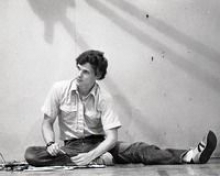Highlights from the Ethnomusicology Archive: the Aman collection

The Aman Folk Ensemble had its roots in a UCLA student dance group called the UCLA Village Dancers. In 1963, the campus group was re-conceived by Anthony Shay (Associate Professor of Dance at Pomona College) and Leona Wood (painter and dancer), as Aman. Aman became the first Los Angeles based dance company to perform at the Los Angeles Music Center and gained an international reputation for the scope of its programming and the versatility of its performers. “Aman's eclecticism is a reminder that America is a nation of people from many nations," wrote Jack Anderson in a 1979 New York Times review. "Moreover Aman implies that national traditions should be cherished, rather than scorned. And by making its programs so varied, it expresses the hope that different cultures may exist harmoniously." Los Angeles Times music and dance critic Martin Bernheimer put it more simply, calling Aman "one of the finest ethnic companies anywhere. Repeat: anywhere."
Aman also had a connection to UCLA Ethnomusicology. To quote from a 1972 oral history interview with Mantle Hood:
MILLER: What is the connection between the Aman group and the Institute of Ethnomusicology?
HOOD: We have been, several of us on the staff of the institute, oh, Boris Kremenliev and I, at least those two, perhaps David Morton at one point, individually [are] faculty sponsors of Aman, which is required in order for them to have any kind of UCLA affiliation ... this year [1972] for the first time we are now officially sponsors of Aman, the Institute, and this with the blessings and, in fact, advice and guidance of one of the vicechancellors. And I think it's a good thing, because I've watched that group build and develop and, knowing it from the very beginning when it first started and then seeing what they've done recently at the Music Center, I think it's an amazing growth and accomplishment in really a relatively short time and, so far as I'm aware, totally financed by their own bootstrap operation. By now it's quite a company, and we think at this point—and are delighted that we might be able to help a little—that university affiliation in a more official way will help them in a number of ways. It will probably attract outside financing, which they badly need, and can further their research base. As you know, they have stressed this from the beginning, so that any numbers they put on are prefaced by a lot of digging and research to be sure the costumes are right and the dances and song texts and so on, so that we hope this now rather official affiliation will be of some benefit.
Alas, the legendary Aman closed in 2004, 41 years after its founding. In 2005, members of Aman donated a collection of audiovisual recordings to the UCLA Ethnomusicology Archive. 20 titles from that collection are now online as part of California Revealed (formerly the California Audiovisual Preservation Project.) I thought I would highlight several of the recordings.
Aman Folk Ensemble, Making of "Light," 1993. Aman Folk Ensemble's first work in modern dance/folk fusion, collaborating with composer-choreographer Laura Dean. The 24-month project was funded by Phillip Morris, the Lila Wallace-Reader's Digest Fund and the National Endowment for the Arts. The finished work, "Light," was a special commission made to celebrate the 30th anniversary of the Los Angeles-based Aman Folk Ensemble. In addition to choreography, Dean is credited with costume design and music, co-composed with Aman's John Zeretzke. "Light" made its Los Angeles premiere in June 1994 at UCLA.
Aman on KCET, 1977.
Madame Xu Shuying with Aman,1981. Madame Xu Shuying was an expert on minority folk dances from China. Madame Xu called dance a kind of international body language and described Chinese ethnic dances ranging from the shoulder-twitching Mongolian style (suggesting the horseman's life) to Han "flower" dances or the suppressed Korean minority's relatively constrained movements. She said the challenge is to find ways to "maintain and develop and pass on" dance traditions (and those of all art forms) yet "still maintain the characteristics of the minorities." Madame Xu toured the U.S. as part of the Dance Exchange Program and visited several U.S. cities, including Los Angeles and San Francisco.
Nihon Odori: Gasa Odori; Oni Odori (technique) by Miyoko Komori, sensei, 1970s. Rev. Mas Kodani of Senshin Buddhist Temple (Los Angeles, Calif.) credited Miyoko Komori (d. 2011) for helping to create the communal spirit of Obon (Ullambana) dancing that exists today. In the 1970s, the reverend asked Komori to choreograph dances for the Buddhist churches in an effort to revive a communal folk style of dancing. “Komori is the person who changed the Bon dancing from a performance to participation. Rather than showing, dancing without one’s ego is the basis of Buddhist dance. The Bon dancing that Komori has choreographed is the dance everybody can master and enjoy. Without her, we would not have this Bon dancing style today,” said Kodani. She also started choreographing Bon dances at the Nishi Honganji temples where various summer festivals took place. “It is amazing to know that the dances that my sister choreographed are still cherished among Japanese Americans.” Nakamura Komori said. In 2007, the BCA (Buddhist Churches of America) Southern District temples recognized Komori’s contribution to restoring Obon dancing to its traditional roots, and Komori received a City of Los Angeles Certificate of Recognition presented by Councilmember Jan Perry. According to the BCA, “Komori-sensei’s dances have stories, so they are easy to learn and fun to dance.” As a dance instructor, Komori started teaching at East Los Angeles College in the 1970s and taught there until her death in 2011.
To view all the Aman recordings currently online.
Top image: Don Sparks, artistic director of the Aman Folk Ensemble at the Japan America Theatre, Los Angeles, 1984. From the Los Angeles Times Photographic Archive. Department of Special Collections, Charles E. Young Research Library, UCLA.





